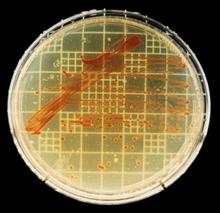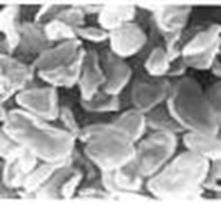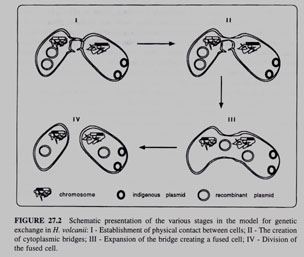Difference between revisions of "Haloferax volcanii"
| (4 intermediate revisions by the same user not shown) | |||
| Line 1: | Line 1: | ||
Haloferax volcanii is a halophile originally discovered in the Dead Sea. It has a disc or cupped shape and reproduces by building cytoplasmic bridges with others in the Haloferax genus and sharing genetic information [http://microbewiki.kenyon.edu/index.php/Haloferax]. As with most halophiles, it requires a high salt concentration in order to thrive. | Haloferax volcanii is a halophile originally discovered in the Dead Sea. It has a disc or cupped shape and reproduces by building cytoplasmic bridges with others in the Haloferax genus and sharing genetic information [http://microbewiki.kenyon.edu/index.php/Haloferax]. As with most halophiles, it requires a high salt concentration in order to thrive. | ||
| + | [[Image:image004.jpg]] | ||
[[Image:image006.jpg]] | [[Image:image006.jpg]] | ||
| − | |||
Haloferax volcanii growing on an agar plate and a microscopic view of its disc shape [http://mail.scu.edu.tw/~93134037/H.volcnii.htm]. | Haloferax volcanii growing on an agar plate and a microscopic view of its disc shape [http://mail.scu.edu.tw/~93134037/H.volcnii.htm]. | ||
It was originally classified in the genus Halobateria, but due to its unique structure and low sodium chloride requirement (as compared to other halobacteria), it was eventually placed in in the Haloferax genus. There are two separate sequencing projects associated with this species. They are "in progress" by San Diego State University and TIGR [http://www.ncbi.nlm.nih.gov/sites/entrez?db=genomeprj&cmd=Retrieve&dopt=Overview&list_uids=12524]. | It was originally classified in the genus Halobateria, but due to its unique structure and low sodium chloride requirement (as compared to other halobacteria), it was eventually placed in in the Haloferax genus. There are two separate sequencing projects associated with this species. They are "in progress" by San Diego State University and TIGR [http://www.ncbi.nlm.nih.gov/sites/entrez?db=genomeprj&cmd=Retrieve&dopt=Overview&list_uids=12524]. | ||
| + | |||
| + | Of particular note about this species is its mating method. Haloferax volcanii is one of only two archaeal species in which a natural process of genetic exchange has been observed [http://www.nottingham.ac.uk/genetics/people/allers/research.php]. Shown below is a diagram detailing the formation of a cytoplasmic bridge between archaea, the sharing of genetic information, and the separation of the two daughter cells. | ||
| + | |||
| + | [[Image:Mating.jpg]] | ||
| + | |||
| + | The University of San Diego has reduced the genetic material to only 5 contigs, comprised of 4012900 base pairs. All 5 contigs can be found here: [http://edwards.sdsu.edu/halophiles/Haloferax_volcanii_ATCC_29605/Raw_454_Data/assembly/454AllContigs.fna H. volcanii contigs] | ||
Latest revision as of 16:18, 20 October 2009
Haloferax volcanii is a halophile originally discovered in the Dead Sea. It has a disc or cupped shape and reproduces by building cytoplasmic bridges with others in the Haloferax genus and sharing genetic information [1]. As with most halophiles, it requires a high salt concentration in order to thrive.
Haloferax volcanii growing on an agar plate and a microscopic view of its disc shape [2].
It was originally classified in the genus Halobateria, but due to its unique structure and low sodium chloride requirement (as compared to other halobacteria), it was eventually placed in in the Haloferax genus. There are two separate sequencing projects associated with this species. They are "in progress" by San Diego State University and TIGR [3].
Of particular note about this species is its mating method. Haloferax volcanii is one of only two archaeal species in which a natural process of genetic exchange has been observed [4]. Shown below is a diagram detailing the formation of a cytoplasmic bridge between archaea, the sharing of genetic information, and the separation of the two daughter cells.
The University of San Diego has reduced the genetic material to only 5 contigs, comprised of 4012900 base pairs. All 5 contigs can be found here: H. volcanii contigs


